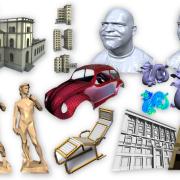Typically, 3D game and virtual environments are created using off-the-shelf software like Autodesk Maya or MAX. While these tools allow professional artists to produce very high-quality models, this task is becoming more and more labour intensive and time consuming, and therewith expensive, as the detail expected from virtual worlds is continuously increasing. This is one of the most important problems in game development, so that finding suitable automatic modelling techniques has become somewhat of a holy grail of the game industry.
In the Gameworld project, we aim to facilitate and automate the process of generating interactive 3D models, while still giving the designer a high level of control over the visual and architectural style of the created models. We will go beyond modelling building facades, and cover more general objects, including street networks and green spaces, urban furniture, indoor environments, and semantic gameplay annotations.
In order to achieve this goal, we will use sophisticated procedural design grammars, precursors to which have already been developed at the Vienna University of Technology and the Arizona State University. We expect this approach to lead to tools that can be applied in production environments, significantly reducing the effort required to create interactive worlds. Potential application areas of this technology are not limited to video games, but include any field using virtual environments.
The project team combines scientific and industrial experience in an ideal way. The academic partners have already been cooperating on research into procedural modelling techniques previously. Sproing is Austria's leading video and computer game development studio, and will bring its long standing experience and knowledge about the needs of the game development industry to the table.
Funding
- FFG 813387
Research Areas
- In this area, we focus on researching methods and algorithms that facilitate creation, representation, analysis and processing of 3D models.
Publications
| Image | Bib Reference | Publication Type |
|---|---|---|
| 2011 | ||
 |
Markus Lipp, Daniel Scherzer, Peter Wonka , Michael Wimmer , Michael Wimmer Interactive Modeling of City Layouts using Layers of Procedural Content Computer Graphics Forum (Proceedings EG 2011), 30(2):345-354, April 2011. [  draft] draft] |
Journal Paper with Conference Talk |
| 2010 | ||
 |
Markus Lipp Direct Artist Control for Procedural Content Generation of Urban Environments Supervisor: Michael Wimmer  [  Thesis] Thesis] |
PhD-Thesis |
 |
Markus Lipp, Peter Wonka , Michael Wimmer , Michael Wimmer Parallel Generation of Multiple L-Systems Computers & Graphics, 34(5):585-593, October 2010. [  preprint] preprint] |
Journal Paper (without talk) |
 |
Johannes Scharl Artist-Controlled Modeling of Urban Environments [  poster] [ poster] [ thesis] thesis] |
Master Thesis |
Martin Ilčík , Markus Lipp, Johannes Scharl, Michael Wimmer , Markus Lipp, Johannes Scharl, Michael Wimmer Procedural Modeling of Urbanistic Scenes, 9. June 2010, Austrian-Russian Joint Seminar - Visual Computing in Fundamental, Academic and Applied Science and Research, Vienna, Austria |
WorkshopTalk | |
 |
Martin Ilčík , Stefan Fiedler, Werner Purgathofer , Stefan Fiedler, Werner Purgathofer , Michael Wimmer , Michael Wimmer Procedural Skeletons: Kinematic Extensions to CGA-Shape Grammars In Proceedings of the Spring Conference on Computer Graphics 2010, pages 177-184. May 2010. [  draft] [ draft] [ presentation-pdf] presentation-pdf] |
Conference Paper |
 |
Ralf Habel, Michael Wimmer Efficient Irradiance Normal Mapping In Proceedings of the ACM SIGGRAPH Symposium on Interactive 3D Graphics and Games 2010, pages 189-195. February 2010. [  paper] paper] |
Conference Paper |
 |
Johannes Unterguggenberger Connected meshes for procedural humans [  report] report] |
Student Project |
 |
Patrick Kühtreiber Inverse Kinematics for Shape Grammars |
Student Project |
 |
Christian Niederreiter Similarity Detection for Urban Modeling [  thesis] thesis] |
Student Project |
 |
Ingo Radax Levels of Detail for Procedural Modeling |
Student Project |
 |
Frederico Dusberger Mesh-Subdivision Methods in CGA Shape Grammars |
Student Project |
| 2009 | ||
 |
Markus Lipp, Peter Wonka , Michael Wimmer , Michael Wimmer Parallel Generation of L-Systems In Vision, Modeling, and Visualization Workshop (VMV) 2009 , pages 205-214. November 2009. [  paper] paper] |
Conference Paper |
Werner Purgathofer , Markus Lipp , Markus LippInteractive Visual Editing of Grammars for Procedural Architecture, 20. October 2009, Visual Computing in Fundamental, Academic and Applied Science and Research, Moskau, Russia |
WorkshopTalk | |
 |
Markus Lipp, Peter Wonka , Michael Wimmer , Michael Wimmer Parallel Generation of L-Systems Poster shown at High-Performance Graphics 2009 ( 1. August 2009- 3. August 2009) |
Poster |
 |
Ralf Habel, Alexander Kusternig, Michael Wimmer Physically Guided Animation of Trees Computer Graphics Forum (Proceedings EUROGRAPHICS 2009), 28(2):523-532, March 2009. [  draft] draft] |
Journal Paper with Conference Talk |
 |
Stefan Fiedler Procedural Human Posing Using CGA Grammars [  image] [ image] [ report] report] |
Student Project |
| 2008 | ||
 |
Markus Lipp, Peter Wonka , Michael Wimmer , Michael Wimmer Interactive Visual Editing of Grammars for Procedural Architecture ACM Transactions on Graphics, 27(3):102:1-10, August 2008. [  paper] paper] |
Journal Paper with Conference Talk |
| Gernot Gebhart Automatisches Generieren von 3D-Straßensystemen |
Master Thesis | |
| 2007 | ||
 |
Markus Lipp Interactive Computer Generated Architecture [  Thesis] Thesis] |
Master Thesis |

